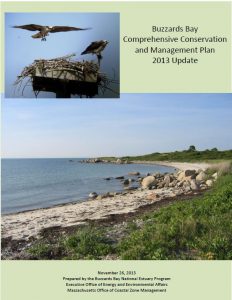2013 CCMP, Action Plan 12:
Protecting Open Space
About the new Buzzards Bay CCMP Action Plans
The Buzzards Bay Comprehensive Conservation and Management Plan (CCMP) was updated in November 2013 to reflect the great progress achieved since the original CCMP was finalized. You can download the entire document (buzzards-bay-ccmp-2013-update.pdf) or just this action plan Protecting Open Space.
Regional Open Space Plan Finalized in 2009
One of the supporting documents to our Open Space Protection Action Plan is the Regional Open Space Plan finalized in 2009 by the Buzzards Bay NEP. The purpose of this plan is to encourage communities and land conservation organizations in the watershed to work cooperatively toward land acquisition and protection goals on a regional scale; to protect biodiversity and safeguard water resources through the protection of undeveloped lands in their natural state; to help leverage funding and resources for open space protection; and to provide a clear and cohesive direction for land protection in Southeastern Massachusetts that is consistent with existing state goals. This planning document will also assist state and federal agencies target public funding for land acquisition.
Please read our Regional Open Space Plan (9.6 MB pdf). This cover letter accompanied the draft report to the towns.
Protecting Open Space
Problem
There are many different land uses within the Buzzards Bay watershed, but much of the watershed remains undeveloped. However, undeveloped land has been disappearing at a rapid rate. In 1971, 64.5% of the watershed consisted of open and unperturbed forestlands and only 12.9% was developed . By 1999, open and unperturbed forested lands decreased to 56.5% of the watershed, while developed lands increased to 19.8%. The percent of lands classified as developed continues to increase, especially in the more rapidly growing communities.
There are ecological, cultural, and aesthetic reasons to protect open space. Naturally vegetated landscapes control flooding, can protect water supplies, reduce erosion, reduce pollutants from watersheds, and provide upland and wetland habitat. Despite these and other ben-efits, protection of open space and habitat is a financial and political challenge for most municipalities; several communities in the Buzzards Bay watershed still have not identified protection needs through open space and master plan development and updates. Some municipalities have considerable amounts of open space; some have modest amounts of open space.
Goal
Goal 12.1. Preserve the ecological integrity of Buzzards Bay and its watershed by increasing the amount of permanently protected open space.
Objectives
Objective 12.1. Improve and protect coastal and inland surface water quality through land protection.
Objective 12.2. Protect biodiversity in the watershed.
Objective 12.3. Protect the region’s groundwater supplies.
Objective 12.4. Improve the land conservation community’s ability to protect open space.
Approaches
Meeting the goals of this action requires that towns and land trusts acquire properties for conservation purposes, or property owners agree to protect permanently their properties for conservation purposes, or in the case of farmlands and surrounding habitat, for farming pur-poses. Because the acquisition of open space can be expensive, even for properties mostly wet, the use of conservation restrictions and agricultural preservation restrictions are important tools to encourage private open space protection. These private land protection strategies are driven by financial and tax benefit incentives offered by government.
Because the purchase of open space can be costly, and state and local governments typical have limited funds for these purchases, it is important that municipalities develop broad strategies and goals for open space protection. These can be articulated in municipal open space plans. These plans must be updated every seven years to remain valid and ensure that the municipality is eligible to receive state grants for open space protection.
Another mechanism to generate local funds is for municipalities to adopt the Community Preservation Act. By adopting this legislation, municipalities can levy a tax fee on property transfer, and some of this revenue is matched by a state fund.
Finally, open space can be protected at no cost to government by allowing cluster development and transfer of development rights. These innovative approaches require approval by the municipal legislative body and planning boards.
Costs and Financing
The preparation and updating of open space plans can be done in-house by municipalities with assistance from the Buzzards Bay NEP or land trusts, or completed by a contractor to the municipality (perhaps a cost of $20,000). Raising money for land acquisitions can be met by donations, municipal appropriations, or by grants. Local adoption of the Community Preservation Act is the best approach to ensure a local revenue stream. Often land acquisitions are complex and may involve funding from multiple sources.
Measuring Success
Ultimately, the number of acres of wetlands and habitat protected (by communities and in the watershed) is the principal mechanism of tracking the success of this action plan. Programmatic tracking of municipal actions, like the approval of open space plans, adopting the Community Preservation Act, and tracking the number of towns without valid open space plans may also be used.
